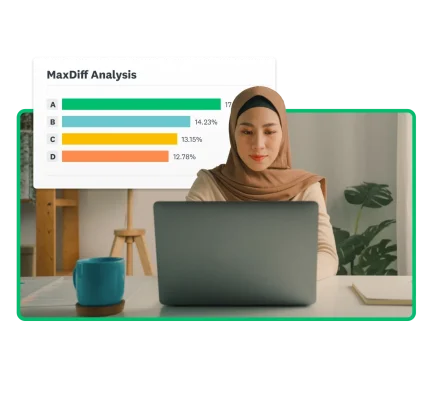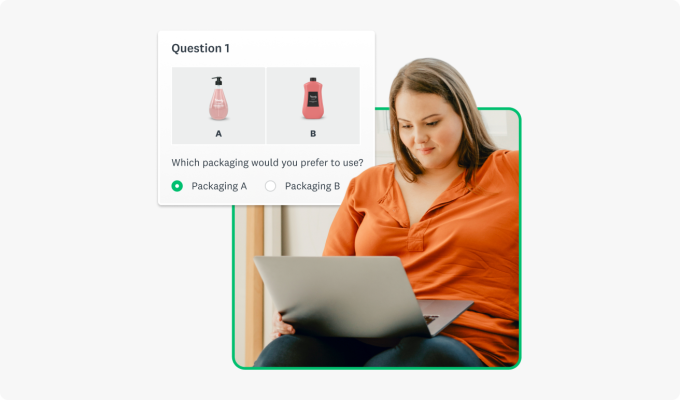Consumer research: How to turn customer insights into results
Understand your customers’ needs and preferences by conducting consumer research.

In times of economic uncertainty, every marketing dollar and business decision carries greater weight. Companies can’t afford to rely on guesswork, making consumer research essential for informed, strategic decision-making.
In 2023, the market research (MRX) industry generated over $84 billion, highlighting a growing demand for data insights. Acting on consumer behavior insights helps companies adapt to market changes, optimize offerings, and boost sales by improving the customer experience.
In this guide, we’ll share the common types of consumer research methodology, why they’re important, and best practices for conducting your own consumer study.
What is consumer research?
Consumer research definition
Consumer research is a subset of market research that prioritizes investigating customers’ motivations, preferences, and purchase behavior.
Consumer opinions are crucial in understanding these preferences, buying behaviors, and motivations. By identifying their needs, preferences, and purchase drivers, consumer research reveals why customers behave as they do.
Consumer research vs. market research
Consumer research and market research are not interchangeable terms. Market research is an all-purpose term for collecting data to answer defined questions. Consumer research studies customer behavior to gather business insights to aid in decision-making.
Why is consumer research important?
Consumer research offers many benefits, from improving product development to evaluating your competitors to driving business growth.
Common benefits include:
Understanding customer needs
Perhaps the most obvious benefit of consumer research is understanding your customers’ needs and wants. Consumer market research identifies a target market’s pain points, buying behaviors, and preferences.
It can also help you answer questions like:
- Who are our ideal customers?
- What do customers want in a solution to XYZ?
Understanding customer needs is necessary for businesses to create and market products effectively.
Improving product development
Product development is an iterative process that requires input from customers to tailor product offerings effectively. Consumer research data helps product development teams align product design with customer preferences.
Example of consumer research for product development
A cosmetics company conducts consumer surveys and focus groups to gather feedback on its new skincare line. This approach helps them refine their products to better meet customer expectations.
A cosmetics brand plans to release three new shades into an existing line of their best-selling lipsticks. After conducting consumer research, the data shows that only two shades are attractive to their target market. The company decides to eliminate the third shade, knowing that money, effort, and resources will be more wisely spent on the two more popular shades.

Enhancing marketing strategies
Marketing teams also benefit from consumer research and use customer preference, motivation, and behavior insights to improve their strategies.
Consumer research reveals how to best reach your target audience via marketing. Preferences for branding elements can significantly influence buying decisions, and marketing professionals rely on consumer insights to tailor a brand’s messaging strategy. Brands can gather data on customer perception, which digital channels to use, and more to improve marketing strategy.
Learn how Sakura used SurveyMonkey Audience to conduct concept testing on its products and got market feedback in record time.
Predicting market trends
A rapidly changing market makes it difficult for brands to effectively tailor their products and marketing campaigns to customers. Marketers can use data collected in consumer research surveys to predict future market demands. Gathering customer feedback on their purchasing habits, attitudes, and desires allows you to reveal trends.
Boosting customer satisfaction
Customer satisfaction drives brand loyalty, retention, and positive word-of-mouth. Using key insights from consumer research, turn customers into brand advocates. Adjust your business strategy according to your findings to boost customer satisfaction. Consumer research gives businesses insights into different consumer groups’ pain points and expectations.
Measure customer satisfaction using our expert-written Customer Satisfaction Survey Template.
Reducing business risks
Reduce business risks by making proactive adjustments to your products and marketing strategies. Some examples of how to use consumer research are validating product-market fit, adapting to market changes, and optimizing pricing strategies. Regularly collecting and analyzing consumer data allows businesses to mitigate risks effectively.
Improving brand loyalty
The insights gathered from consumer research can transform your brand loyalty strategy. Learn what customers truly value, their perception of your brand, and more. Improve brand loyalty to create a solid foundation for your business.
Excellent customer service and high-quality products are essential to boosting brand loyalty. Measure your brand loyalty using Net Promoter® Score (NPS), customer loyalty index, and customer satisfaction surveys.
Segmenting and defining the audience
Consumer research goes beyond simple demographic information. Demographics only cover areas like consumer gender identification, age, income, or marital status.
A consumer research survey includes psychographics such as interests, attitudes, behaviors, and values so you can target the right market. Psychographic data helps your business further segment and define its audiences.
Evaluating competitors
Consumer research aids businesses in assessing competitors and understanding how buyers interact with other brands.
Ask consumers about their experiences and opinions on your competitors’:
Product quality
- How would you rate the quality of [Product] compared to [Competitor’s Product]?
- What aspects of [Product] do you think are superior or inferior to [Competitor’s Product]?
- Have you ever switched from [Competitor’s Product] to [Product] (or vice versa) because of quality? Why?
Price versus value
- Do you feel [Product] offers better value for the price compared to [Competitor’s Product]? Why or why not?
- Would you be willing to pay more for [Product] if it offered additional features or benefits?
- How does the price of [Product] influence your decision compared to [Competitor’s Product]?
Branding
- How would you describe [Brand] in terms of trust and reputation compared to [Competitor’s Brand]?
- What words or emotions come to mind when you think of [Brand] versus [Competitor’s Brand]?
- Have you ever chosen [Brand] over a competitor because of its image, values, or messaging? Why?
Gather qualitative and quantitative data to derive insights from to support your business.
Examples of using consumer research to understand the competition
An automobile manufacturer conducts research to identify different customer segments based on factors like age, income, and lifestyle.
Consumer researchers play a crucial role in advancing knowledge related to economic inclusion within the banking and financial sectors.
Business growth
All of the other benefits of consumer research mentioned support a business’s overall growth. Consumer research helps businesses identify unmet needs in their target market.
Businesses can increase sales by understanding customer pain points, shopping preferences, and demographics. Consumer research surveys give businesses the insight needed to strengthen their brand positioning.
Update your products and services
Use customer feedback to refine products or services to meet customers’ needs and expectations. Consumer research plays an important role in product development and improvement. Product teams can gauge interest in products or gather feedback on product issues to solve.
For example, consumer research regarding a brand’s e-commerce app could reveal that users find the interface difficult to navigate. The development team then takes the feedback to make updates to improve the app’s UX.
Types and methods of consumer research
Consumer research can be conducted for many purposes, from exploration to measuring satisfaction. Next, we will discuss the differences in consumer research types and how businesses can use them to inform their strategy.
Types of consumer research
Exploratory consumer research
Exploratory research collects feedback from consumers familiar with your product or the problem it solves. This open-ended qualitative research method gathers impressions from consumers to understand your market.
Use this research type to collect qualitative responses that can’t be quantified but helps teams identify emerging trends. Additionally, exploratory consumer research helps businesses develop stronger hypotheses for advanced market research.
Descriptive consumer research
This type of consumer research collects qualitative and quantitative data from survey respondents. It allows businesses to gain a realistic understanding of their brand’s consumer perception.
Descriptive consumer research surveys utilize multiple-choice, demographics, rating scales, and open-ended questions. This mixed format results in impactful and actionable insights for your business.
Correlational studies in consumer research
Correlational research considers whether a specific variable in your study, such as gender, correlates with another variable, like how likely a participant is to purchase a product.
It uses data from close-ended questions to calculate the correlation coefficient between variables. Businesses often use correlational research to develop predictive models for consumer behavior.
Experimental methods in consumer research
You may also consider using experimental research methods for consumer research. In this scenario, you monitor if changing an independent variable, such as price, impacts a dependent variable, like purchase intent. This type of consumer research enables businesses to test specific hypotheses and gather quantifiable data.
Quantitative research
Quantitative research occurs when a business asks consumers questions that yield quantifiable results. For instance, a business may use rating scales to measure customer satisfaction or opinions.
Asking, “On a scale of 1-5, how would you rate your satisfaction with the product?” gives researchers measurable insights. Quantitative research uses closed-ended questions with pre-set response options to gather numerical data—think percentages, averages, etc.
Qualitative research
Qualitative research is the opposite of quantitative research and cannot be measured numerically. Qualitative consumer research uses open-ended questions to obtain detailed responses.
In this type of survey, customers can share anecdotes about their behaviors and motivations. Qualitative studies ask open-ended questions that let you collect ideas and anecdotes from your target market.
Causal research
Causal research, sometimes called explanatory research, helps teams understand cause-and-effect relationships. This type of research identifies the impact of a change in one variable on another. Businesses use causal research to explain why something happened, such as the effect of branding or product changes.
For example, a business might use causal research to determine if consumers buy more of a product in pink vs. its standard packaging. The benefit of causal research is after an initial experiment is completed, researchers can apply the results to alternative scenarios.
Customer satisfaction research
This type of research measures how satisfied customers are with a brand’s products or services. Customer satisfaction (CSAT) surveys equip businesses with consumer insights that help them improve their offerings. You can use them at various points of the customer journey.
CSAT scores determine the percentage of satisfied customers, with “good” scores falling between 70% and 85%.

Consumer research methods
There are a handful of consumer research methods businesses should know. But how do you know which consumer research method to choose? Below, we’ll explain each method and when to use it.
Surveys
Surveys are the holy grail of consumer research in marketing as they allow researchers to collect a large amount of data quickly. They simplify collecting both qualitative and quantitative data from a representative sample of your market.
Advancements in consumer research make it easy for your business to conduct its market research without hiring outside help. From concept testing to monitoring online shopping attitudes, surveys enable teams to gather consumer insights.
Use our expert-written Market Research Survey Templates to get started collecting consumer data.
Interviews
Holding interviews is another common practice in consumer research. One-on-one interviews enable researchers to collect qualitative data on consumer preferences, motives, and behaviors. Researchers can also read participants’ reactions and ask follow-up questions based on their answers. In-depth interviews encompass individual, one-on-one dialogues between a researcher and a participant, allowing for a deeper understanding of consumer insights.
Focus groups
Focus groups allow consumers to come together and establish a consensus to questions. This method is particularly useful for seeing how consumers in your target market influence each other. Focus groups involve a small group of participants who discuss a specific product, service, or topic under the guidance of a moderator.
No time to host focus groups? SurveyMonkey Audience helps teams get the same data in a fraction of the time.
Observation
For this research method, researchers observe and record consumer behavior in natural or controlled settings. This method allows researchers to gain insight into how consumers interact with products. It also helps teams understand people’s decision-making processes more deeply.
Another approach involves using diaries and journals, where participants record their thoughts, experiences, and product usage over a specified period.
Experiments
Experiments, like A/B testing or field tests at a business location, let you test how variables like price and packaging affect the consumer behavior of your target market.
Experiments enable researchers to understand cause-and-effect relationships between variables. Controlled experiments involve manipulating one or more variables to understand their impact on consumer behavior.
Social listening
Social listening is when researchers monitor consumers’ online activity and public conversations about a brand, product, or industry.
This consumer research method is an effective way to better understand customer perception and preferences in real-time. Businesses can get unfiltered, candid feedback from consumers by monitoring online mentions.
Customer feedback
Customer feedback via feedback forms is another way to gain insights into consumer behavior, preferences, and more. Provide opportunities for customers to leave feedback beyond product or business reviews.
Implement feedback forms into your shopping process to regularly collect valuable customer feedback. Feedback can be analyzed to identify trends and inform decision-making. Mystery shoppers visit stores or use services and report on their experiences, offering another layer of consumer insights.
Market analysis
Market analysis enables businesses to understand their target market and tailor their brand offerings deeply. Researchers should analyze customer demographics, psychographics, market size, competitors, and pricing to understand their market. Researchers can also identify trends to predict future customer behavior and market demands.
Online analytics
Using online analytics tools or platforms like SurveyMonkey allows businesses to easily collect, organize, and analyze consumer data. Online analytics streamline consumer product research for marketing teams. Teams can use key findings to improve their products and how they market them.

How to do consumer research (with best practices)
The consumer research process is straightforward and can be outlined in six simple steps:
Step 1: Define objectives
Before setting out to conduct consumer research, you must set clear objectives to stay on track. Ask yourself, what do you want to learn about your consumers? What information will help you make an informed business decision?
Teams can define objectives by choosing what they want to uncover about their target market. You may be looking to update your marketing strategy to better align with customer preferences. Or maybe you want to see the cause-and-effect relationship between two variables.
Step 2: Identify your target audience
Next, you should identify what audience you are targeting specifically. When choosing a target audience, consider demographic factors, such as age, income level, gender, etc. Also consider psychographics like values and interests, along with location and purchasing habits.
Researchers can tailor their consumer research questions to their audience and directly address relevant concerns or interests.
Step 3: Choose your research methods
The research methods you choose will determine the type of data you collect. Consider the objectives of your research to help you choose the best methods.
The best consumer research surveys use both qualitative and quantitative methods to gather data. This means using closed-ended question formats like ratings, scales, and multiple-choice questions.
However, researchers should also include a couple of open-ended questions that collect qualitative data. This hybrid approach allows researchers to extract deeper insights from reliable data.
If using a survey, write great survey questions by providing balanced answer options to closed-ended questions. In general, closed-ended questions should make up most of any survey because they provide conclusive results. Asking fewer open-ended questions also improves completion rates.
Another important part of writing effective questions is asking only one thing at a time to ensure a clear and relevant answer. Make making each question distinct to avoid straightlining.
Avoid phrasing that implies a desired answer to get the most honest results from consumers. This way, you don’t accidentally influence how consumers respond.
Step 4: Collect data
Use the research methods you chose to collect data from your target audience. This can be done through surveys, interviews, focus groups, feedback forms, etc. The data you collect will be used to gain valuable insights in the next step.
Maintain ethical standards as you collect your data, regardless of your collection methods. To maintain ethical standards in consumer research, teams must:
- Obtain informed consent
- Protect privacy and confidentiality
- Provide transparency around the purpose and research methodology
- Adhere to relevant data protection laws
- Present findings unbiasedly
Step 5: Analyze and interpret the data
To turn data into insights, you must analyze and interpret it. First, be sure to cleanse the data to remove any skewed responses or duplicates. Teams should also look back at the research objectives before organizing and analyzing data.
Then, organize the data to more easily identify trends and patterns. Segment your data using demographic data and report key findings to business stakeholders. With SurveyMonkey, you can create a report with easily digestible information.
Lastly, draw conclusions from key findings in your data sets.
Step 6: Take actionable steps based on insights
Once you’ve analyzed the data and drawn conclusions from the insights, make an action plan. Utilize the insights and key findings to improve your branding, messaging strategy, marketing, and products. Consumer research enables brands to better align with customer needs and preferences.
Consumers consistently change due to social influence, market shifts, and other factors. Therefore, it is vital that researchers revisit and update their research to stay aligned with evolving consumer needs. If your team conducts consumer research on a rolling basis, it’s essential to analyze new data frequently.
Conduct effective consumer research with SurveyMonkey
Teams should consider conducting consumer research to enhance their marketing and product development. Effective consumer research empowers teams to make informed decisions that help boost sales and elevate customer experience.
SurveyMonkey provides businesses with a market research solution to make conducting consumer research seamless. Send consumer behavior surveys and market research surveys to collect critical data for your business. Get started with SurveyMonkey today.
Discover more resources

Understand your target market to fuel explosive brand growth
Brand marketing managers can use this toolkit to understand your target audience, grow your brand, and prove ROI.

See SurveyMonkey in action: Event registration and feedback

Hornblower enhances global customer experiences
Discover how Hornblower uses SurveyMonkey and powerful AI to make the most of NPS data, collect customer insights, and improve customer experiences.

Marketing trends: 3 strategies to stay relevant and ready for what's next
New SurveyMonkey research reveals critical insights on the state of marketing. Discover marketing trends to fuel your strategies and stay relevant.
Ready to get started?
NPS, Net Promoter & Net Promoter Score are registered trademarks of Satmetrix Systems, Inc., Bain & Company and Fred Reichheld.